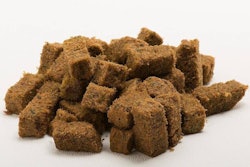
In the current pet food market, health and wellness are key to consumers looking for pet foods that are not overly processed. A new processing method for extruded pet food and treats could help manufacturers in creating their products more safely and efficiently, explained Galen Rokey, Wenger Manufacturing, speaking at Petfood Forum 2016 on April 20.
In traditional pet food processing, the ratio of mechanical to thermal energy required is generally one-to-one, Rokey said. This ratio not only influences product characteristics and determines utility costs per metric ton, but also impacts wear costs per metric ton and affects a company’s “green” status.
But, Rokey explained that shifting this ratio to thermal energy as the main energy source could have many benefits. This process, he said, would involve low specific mechanical energy and gentle extrusion; short time, high-temperature baking in an oven; followed by a mild, final drying step.
Rokey explained that the process causes gasses to form and evaporate; gelatatinzes starches; controls enzyme activity; causes carmelization to occur, thus impacting palatability and color; and causes micro-organisms to die, which means the baking step can also be considered a thermal kill step. In fact, he cited research showing that this baking step reduced enterococcus faecium and Salmonella in the pet food.
He concluded by saying this extrusion-baking process can be beneficial to pet food manufacturers as it allows for flexible ingredient selection and varied product palatability and texture. It also permits adjusting the specific thermal energy to specific mechanical energy ratio, thereby allowing manufacturers to lower energy costs.
Petfood Forum 2016 was held April 18-20 at the Kansas City Convention Center in Kansas City, Missouri, USA.














